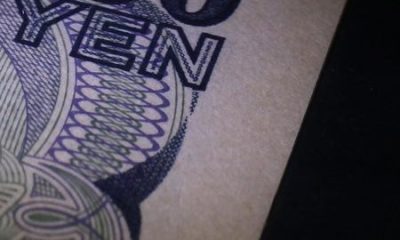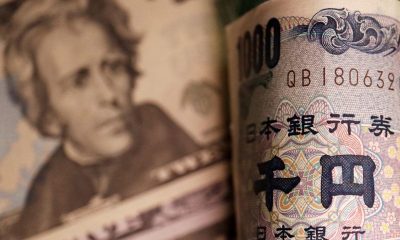Commodities
Oil broadly steady after surprise US crude stock drop
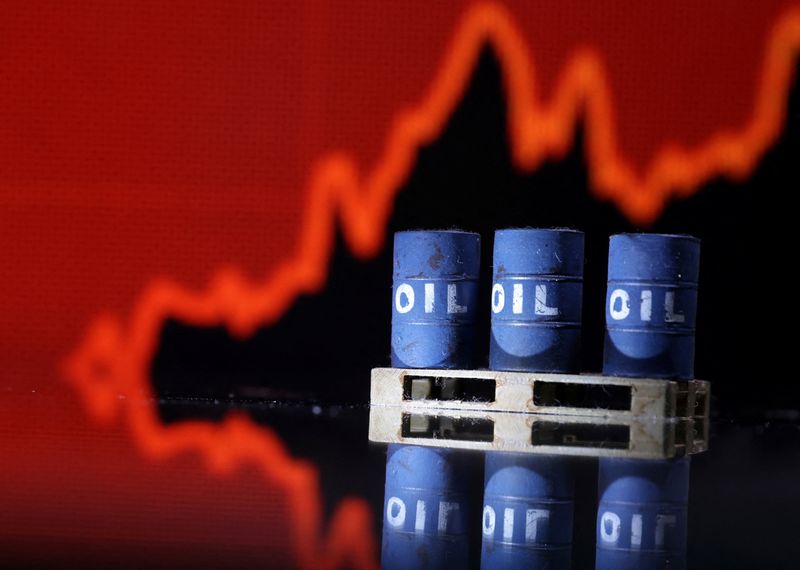
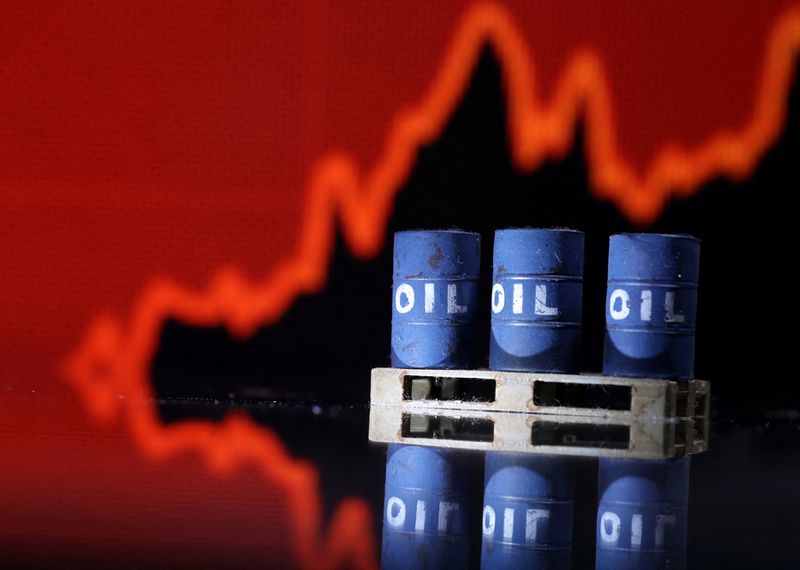
© Reuters. Model of Oil barrels are seen in front of rising stock graph in this illustration, July 24, 2022. REUTERS/Dado Ruvic/Illustration/file photo
By Paul Carsten
LONDON (Reuters) -Oil prices were broadly steady on Thursday, shored up by a surprise stock drop and the U.S. Federal Reserve sticking to its outlook on rate cuts for the year.
futures for May were down 31 cents, or 0.4%, to $85.64 a barrel by 1213 GMT. They fell by 1.6% on Wednesday.
U.S. West Texas Intermediate futures for May were down 30 cents, or 0.4%, to $80.97 a barrel after a fall of about 1.8% in the previous session.
Crude inventories in the United States, the world’s biggest oil consumer, fell for a second week, the U.S. Energy Information Administration (EIA) reported on Wednesday.
Stockpiles unexpectedly declined by 2 million barrels to 445 million barrels in the week ended March 15, as exports rose and refiners continued to increase activity. Analysts polled by Reuters had expected a 13,000-barrel rise. [EIA/S]
“It seems that the bullish mantra is still intact, with yet another unexpected drawdown in U.S. crude inventories last week while market participants continue to price for the risks of further supply disruption on the Russia-Ukraine front, said Yeap Jun Rong, market strategist at IG.
Gasoline inventories fell for a seventh week, down 3.3 million barrels to 230.8 million, suggesting steady strong fuel demand. Oil refinery runs ramped up by 127,000 barrels per day and utilisation rates rose.
Investors also took heart from the U.S. central bank, which held interest rates in a range of 5.25% to 5.50% on Wednesday, but kept to an outlook for three rate cuts this year.
Lower rates could boost economic growth, in good news for oil sales.
Ukrainian attacks on Russian refineries also prompted investors to trade crude at higher prices, factoring in that the strikes could hit global petroleum supplies.
Ukrainian drones have targeted at least seven Russian refineries this month. The attacks have shut down 7%, or around 370,500 barrels per day, of Russian refining capacity, according to Reuters calculations.
Analysts say prolonged disruptions could force Russian producers to reduce supply if they are unable to export crude oil and face storage constraints.
Elsewhere, Germany’s economy was likely in recession in the first quarter of 2024 as weak consumption and anaemic industrial demand continue to push the recovery further into the future, the central bank said in a regular economic report on Thursday.
Also on Thursday, the Bank of England’s governor said Britain’s economy is “moving in the right direction” for the central bank to start cutting interest rates.
Commodities
Oil prices set for steep weekly losses; payrolls could drive sentiment

Investing.com– Oil prices edged higher Friday, lifting from near seven-week lows, but were headed for steep losses this week as signs of robust U.S. stockpiles and production dashed hopes for tight crude markets in the coming months.
At 08:05 ET (12:05 GMT), rose 0.6% to $84.20 a barrel, while gained 0.6% to $79.44 a barrel.
Crude set for hefty losses this week
Despite these gains, both contracts were still trading close to their weakest levels in seven weeks, and were set to lose between 5% and 6% this week.
An unexpected build in U.S. and data showing increased U.S. production suggested that oil markets were not as tight as traders were initially hoping.
This was coupled with easing fears of supply disruptions in the Middle East, as Israel and Hamas continued negotiations over a potential ceasefire.
Concerns over slowing economic growth – which could eat into demand – also came into play this week, especially after the U.S. Federal Reserve warned that it will keep interest rates higher for longer.
Middling data from top crude importer China also factored into fears of sluggish demand. Business activity in the country was seen slowing in April after a strong start to the year.
Markets were also on edge ahead of the release of key U.S. data later in the day, which is likely to factor into the outlook for interest rates.
“The US jobs report which will be released later today, has the potential to be a key driver for oil prices in the immediate term,” analysts at ING said, in a note.
remove ads
.
OPEC+ could extend production cuts
Still, crude found some relief on Friday from a softer , as the greenback retreated in anticipation of the nonfarm payrolls data.
Also helping the tone was a report from Reuters that the Organization of Petroleum Exporting Countries and allies, a group known as OPEC+, could potentially maintain their current run of 2.2 million barrels per day of production cuts beyond the end-June deadline, especially if demand does not pick up.
But cartel members are yet to begin formal talks over the matter. Still, extended production cuts by the cartel could herald tighter markets later in 2024.
Adnoc, the UAE’s national oil company, has increased its production capacity by 200,000 barrels per day to 4.85 million b/d, leaving the producer with a spare capacity above 1.7m b/d, after producing a little over 3.1m b/d in April.
“This could see the UAE push for a higher baseline when OPEC+ discusses its output policy for the second half of 2024,” ING added.
(Ambar Warrick contributed to this article.)
Commodities
Goldman sees potential for gold prices surging above $3000 amid geopolitical risks
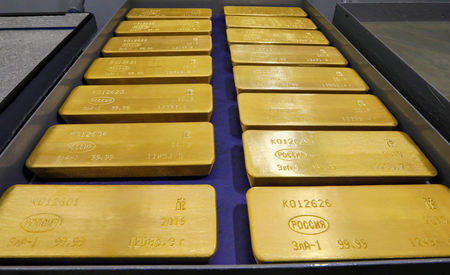
2024 has seen gold prices surge to new record levels, with the yellow metal exceeding $2,400 an ounce last month due to increased global demand amid economic and geopolitical uncertainties.
Remarkably, strategists at Goldman Sachs believe there’s even more upside room for the safe-haven metal, saying it could potentially exceed $3,000 by year’s end.
Gold prices rally on geopolitical unrest, central bank demand
One of the primary drivers of this price rally is the strong demand for gold from global central banks and Asian households.
In China, economic recovery challenges post-pandemic and a depreciating yuan, which has lost about 5% against the US dollar over the past year, make gold even more costly for local consumers.
Despite this, both Chinese consumers and the People’s Bank of China (PBOC) continue to pursue gold avidly.
The PBOC has increased its gold reserves for 17 consecutive months, with a 16% rise in its gold holdings during this period, as reported by the World Gold Council. In March alone, the PBOC added 160,000 ounces of gold to its reserves.
Similarly, countries like Turkey, India, Kazakhstan, and some in Eastern Europe have been active gold buyers this year.
This accumulation reflects a broader trend among global central banks to diversify their reserves and lessen their dependence on the US dollar.
Gold prices witnessed a proper pullback at the end of April, but the bullish sentiment returned this week after Federal Reserve policymakers hinted that rate cuts could be on the horizon.
At its latest policy meeting on Wednesday, the Fed maintained its interest rate stance, as widely anticipated. The policy statement continued to echo previous economic assessments and guidance, suggesting conditions that could lead to a reduction in borrowing costs.
remove ads
.
Fed Chair Jerome Powell stated that any future rate decisions would be data-driven, but he noted that a rate hike was unlikely at this point.
This reassurance from Powell, effectively ruling out further rate hikes, contributed to gold prices staying above $2,300. Lower interest rates further increase gold’s appeal as they typically reduce yields on fixed-income assets like bonds.
Meanwhile, geopolitical tensions, particularly in the Middle East, have also boosted investor interest in the bullion. Gold is considered one of the oldest safe-haven assets, witnessing strong demand during times of geopolitical unrest and wars.
Goldman Sachs says gold prices may exceed $3000
Citing robust demand for gold from emerging market (EM) central banks and Asian households, strategists at Goldman Sachs maintained their base case projection that the precious metal will rise to $2,700 per troy ounce by the end of the year, reflecting a 17% increase.
Using their model, which incorporates previous estimates of gold supply and demand elasticity, Goldman strategists also see potential for even higher gold prices under certain conditions.
Specifically, they predict that if US financial sanctions intensify at a pace similar to that since 2021, gold prices could climb an additional 16% to $3,130 per troy ounce “on the back of additional central bank buying of 7Mtoz annually,” they wrote.
“Such an increase in our US financial sanctions index would be akin to the hypothetical addition of roughly two or more US financial sanctions on China or six financial sanctions on India,” strategists said.
In a second scenario, Goldman estimates that if the US 5-year Credit Default Swap (CDS) spread widens by one standard deviation (13 basis points), gold prices could increase by an additional 14%, reaching $3,080 per troy ounce, driven by central banks purchasing an additional 6 million troy ounces of gold annually.
remove ads
.
“To be clear, the geopolitical, fiscal, and financial outlooks, and their exact impact on central bank gold demand and gold prices are all highly uncertain. That said, our exercise underscores the hedging value of gold against adverse geopolitical or financial scenarios, in which equity-bond portfolios would likely suffer,” strategists added.
Commodities
Oil prices set for steepest weekly drop in 3 months

By Ahmad Ghaddar and Deep Kaushik Vakil
LONDON (Reuters) -Oil prices edged higher on Friday yet remained on course for their steepest weekly loss in three months weighed by concerns about demand and high interest rates.
futures for July rose 43 cents, or 0.5%, to $84.10 a barrel by 1200 GMT. U.S. West Texas Intermediate crude for June was up 34 cents, or 0.4%, to $79.29 per barrel.
Both benchmarks are set for weekly losses as investors are concerned higher-for-longer interest rates will curb economic growth in the U.S., the world’s leading oil consumer, as well as in other parts of the world.
Brent was on course for a weekly decline of about 6%, and WTI for a loss of 5.4% on the week.
“We view the commodities sell-off over the last two days as collateral damage from the Fed repricing and non-fundamental in nature,” JP Morgan analysts wrote in a note.
The U.S. Federal Reserve held interest rates steady this week, and flagged high inflation readings that could delay rate cuts.
The market awaits monthly data due on Friday about U.S. nonfarm payrolls, a measure of labour market strength that the Fed takes into consideration when setting interest rates.
Higher rates typically weigh on the economy and can reduce oil demand.
Also on Friday, energy services firm Baker Hughes is due to release its weekly count of oil and gas rigs, an indicator of future crude output from the world’s top producer. [RIG/U]
Geopolitical risk premiums due to the Israel-Hamas war, which has the potential to lead to oil supply disruption, have also faded as Israel and Hamas consider a temporary ceasefire and hold talks with international mediators.
remove ads
.
“Hopes of a ceasefire and a sharp rise in {{8849|U.S. crcrude oil inventories have caused the price of a barrel of Brent crude to slip below $85,” said Commerzbank (ETR:) analyst Barbara Lambrecht.
Further ahead, the next meeting of OPEC+ oil producers – members of the Organization of the Petroleum Exporting Countries and allies including Russia – is set for June 1.
Three sources from the OPEC+ group said it could extend its voluntary oil output cuts of 2.2 million barrels per day beyond June if oil demand does not increase.
JP Morgan, which expects OPEC+ to extend cuts beyond June, said that a counter-seasonal rise in oil inventories last month would be a concern for the producer group.
“The stock builds in April will turn into draws in May through August and can push prices into the $90s in September,” the bank said.

 Forex2 years ago
Forex2 years agoForex Today: the dollar is gaining strength amid gloomy sentiment at the start of the Fed’s week

 Forex2 years ago
Forex2 years agoHow is the Australian dollar doing today?

 Forex1 year ago
Forex1 year agoUnbiased review of Pocket Option broker

 Forex2 years ago
Forex2 years agoDollar to pound sterling exchange rate today: Pound plummeted to its lowest since 1985

 Cryptocurrency2 years ago
Cryptocurrency2 years agoWhat happened in the crypto market – current events today

 World2 years ago
World2 years agoWhy are modern video games an art form?

 Stock Markets2 years ago
Stock Markets2 years agoMorgan Stanley: bear market rally to continue

 Economy2 years ago
Economy2 years agoCrude oil tankers double in price due to EU anti-Russian sanctions

